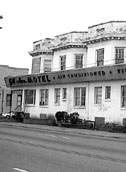|

Comment
on this story
|
 |

by Matt Edens
I went to that Nine Counties/One Vision thing last week—the "Civic Vision for Downtown Knoxville." Heady stuff. We've come a long way from planetariums and glass domes over Market Square. There was, however, one little thing. Our vision's still a little blinkered when it comes to just what in the hell downtown is.
It was as plain as black and white on the maps at the center of each table. Sure, they'd expanded on "downtown" to include the east edge of Fort Sanders, the south bank of the river and the east side's monumental hunks of Sovietski concrete, like the Coliseum and the Safety Building. But to the north downtown slams into the wall at I-40. Emory Place and its environs were, literally, beyond the pale.
Which is unfortunate. Particularly in light of the last, but hopefully not least, of the "Guiding Principles for the Development of Downtown Knoxville," which are theoretically shaping this plan. The principle reads: "Reconnect downtown and the surrounding neighborhoods, both functionally and visually." The hub for so much of the city's street system, Emory Place is critical to making that connection. Central, Broadway, Magnolia, and Fifth Ave. all connect through Emory Place, making it the gateway to the northern, eastern, and northwestern parts of the center city. And from Emory Place, Gay Street funnels directly into the core of downtown. The area could become a strong anchor at the terminus of Gay Street, much like Chattanooga is using their Southside redevelopment district, just beyond the Chattanooga Choo-Choo, to anchor the southern terminus of Broad Street and their electric shuttle system.
Scoff if you will, but consider this. Downtown, according to the 2000 census, contained a mere 64 households with incomes over $50,000 (14 of them earning over six figures). Fourth and Gill and Old North by comparison, contain 244 such households (72 of them six-figure earners), many of them located a five- to 10-minute walk from Emory Place. Viewed in that light, the notion of a Gay Street shuttle seems a good deal less farfetched. Oh, and that's not even counting the 500 college students who live in the area.
So why aren't we redeveloping the heck out of this part of town? An inability to think of "downtown" past the interstate is part of it. But an even bigger obstacle is that—semi-officially—we've already earmarked the area for a whole other use. The past decade has seen a steady growth in the number of homeless shelters and halfway houses of various sorts. The number of people in them around Emory Place has more than doubled over the last decade to 243 (20% of the census tract's total population).
Which brings me to this property, the rather notorious 5th Ave. Motel at the corner of Fifth and Broadway. Ostensibly, in this column I'm supposed to write about property that's for sale. The 5th Ave. isn't—not exactly. Let me explain. Over the past decade the concentration of social service agencies has created a real estate market where the agencies are the only buyers. They admit as much.
A few months ago when the city applied for H-1 Historical Overlay Zoning for the condemned motel, one of the adjacent shelter directors actually stated that the zoning would place an undue constraint on whichever of "them" gets it. The notion that someone other than a social service provider might want the property never entered his mind. Just up the street (beyond a bank branch that was recently shut down), another shelter's abandoned location is the subject of much controversy. The shelter relocated a few doors down, expanding into another commercial property that recently shut its doors. And, to get the abandoned shelter off their books, a deal is being brokered to sell it to yet another social service provider (since, as victims of the market they helped create, they can't sell it to anyone else). Even more ironic is that some booster types are doing everything they can to make the deal happen, because they deem the service provider's current location—south of I-40, in "downtown" proper—an obstacle to redevelopment.
Meanwhile, Chattanooga Neighborhood Enterprise has completed the first phase of Cowart Place. One of the main anchors of the Southside redevelopment effort, the new townhomes (see their website) already sold to a mix of market rate and low/mod income buyers—bear an uncanny resemblance to the "notorious" 5th Ave. Motel.
But only if you take the blinders off.

February 13, 2003 * Vol. 13, No. 7
© 2003 Metro Pulse
|





